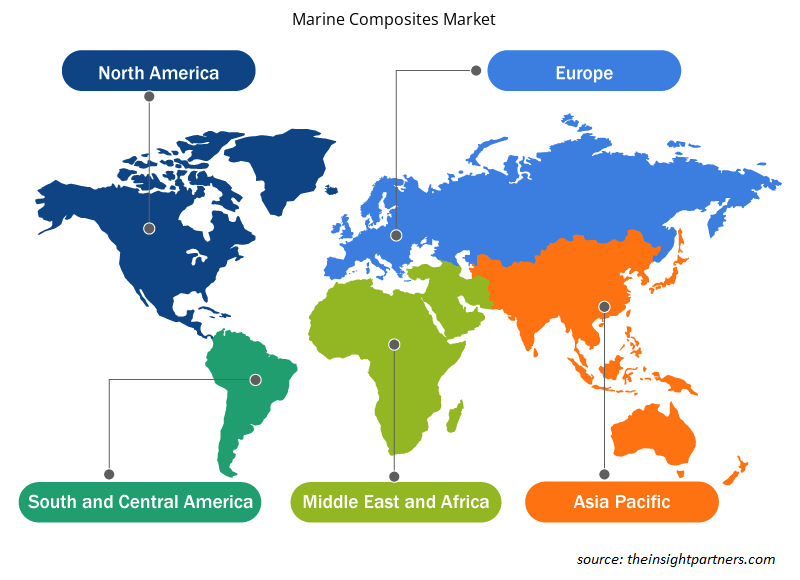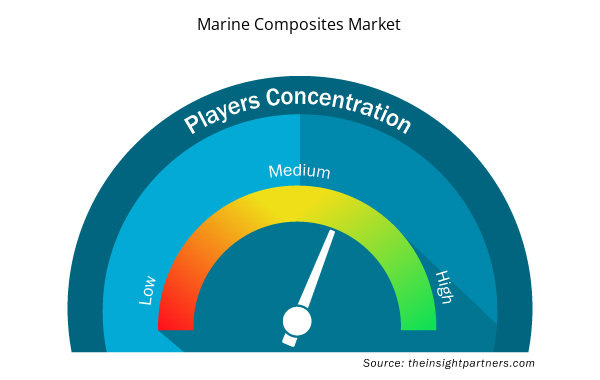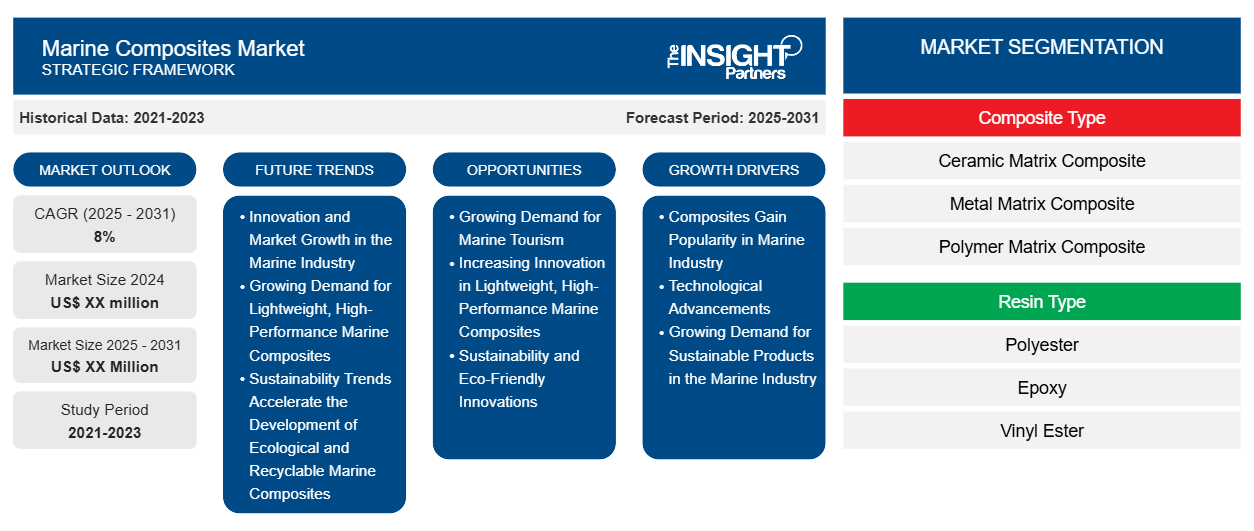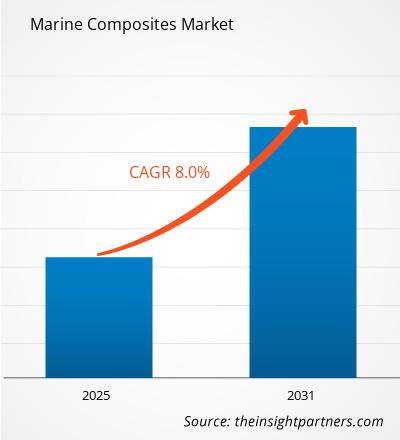Se espera que el mercado de compuestos marinos registre una CAGR del 8% entre 2024 y 2031, con un tamaño de mercado que se expandirá de US$ XX millones en 2024 a US$ XX millones en 2031.
El informe está segmentado por tipo de compuesto (compuesto de matriz cerámica (CMC), compuesto de matriz metálica (MMC), compuesto de matriz de polímero (PMC) y otros). El informe también está segmentado según el tipo de resina (poliéster, epoxi, éster de vinilo, termoplástico y otros) y el tipo de embarcación (veleros, cruceros, barcos a motor y otros). El alcance del informe cubre 5 regiones: América del Norte, Europa, Asia Pacífico, Medio Oriente y África, y América del Sur y Central y los países clave de cada región. El análisis global se desglosa aún más a nivel regional y por países principales. El informe ofrece el valor en USD para el análisis y los segmentos anteriores.
Propósito del Informe
El informe Marine Composites Market de The Insight Partners tiene como objetivo describir el panorama actual y el crecimiento futuro, los principales factores impulsores, los desafíos y las oportunidades. Esto proporcionará información a diversas partes interesadas del negocio, como:
- Proveedores/fabricantes de tecnología: Para comprender la dinámica cambiante del mercado y conocer las oportunidades potenciales de crecimiento, lo que les permitirá tomar decisiones estratégicas informadas.
- Inversionistas: Realizar un análisis exhaustivo de tendencias sobre la tasa de crecimiento del mercado, las proyecciones financieras del mercado y las oportunidades que existen en toda la cadena de valor.
- Órganos reguladores: Regular las políticas y vigilar las actividades del mercado con el objetivo de minimizar los abusos, preservar la confianza de los inversores y defender la integridad y la estabilidad del mercado.
Segmentación del mercado de materiales compuestos marinos
Tipo compuesto
- Compuesto de matriz cerámica
- Compuesto de matriz metálica
- Compuesto de matriz polimérica
Tipo de resina
- Poliéster
- Epoxy
- Éster de vinilo
- Termoplástico
Tipo de embarcación
- Veleros
- Cruceros
- Embarcaciones a motor
Geografía
- América del norte
- Europa
- Asia-Pacífico
- América del Sur y Central
- Oriente Medio y África
Personalice este informe según sus necesidades
Obtendrá personalización en cualquier informe, sin cargo, incluidas partes de este informe o análisis a nivel de país, paquete de datos de Excel, así como también grandes ofertas y descuentos para empresas emergentes y universidades.
- Obtenga las principales tendencias clave del mercado de este informe.Esta muestra GRATUITA incluirá análisis de datos, desde tendencias del mercado hasta estimaciones y pronósticos.
Factores impulsores del crecimiento del mercado de materiales compuestos marinos
- Los materiales compuestos ganan popularidad en la industria marina: los entornos marinos requieren materiales más exigentes, en los que no se corroen ni se degradan fácilmente. Los materiales compuestos suelen resistir bien el agua salada y los componentes corrosivos, lo que a su vez hace que la construcción naval con materiales compuestos sea más atractiva. Esta durabilidad no solo aumenta la vida útil del buque, sino que también reduce el coste de mantenimiento, lo que conduce a la expansión del mercado.
- Avances tecnológicos: Las tecnologías avanzadas de fabricación de compuestos han ayudado a introducir nuevas aplicaciones y mejorar las características de rendimiento. La formulación mejorada de resinas y los refuerzos de fibra mejorados permitirán la producción de compuestos más eficientes y sostenibles para aplicaciones marinas, y el progreso tecnológico es fundamental para satisfacer las cambiantes demandas de la industria marina.
- Demanda creciente de productos sostenibles en la industria marina: La industria marina está avanzando hacia materiales ligeros y de alta resistencia, que mejoran la funcionalidad y reducen el consumo de combustible de los buques. Los materiales compuestos reducen el peso total, lo que permite que los buques viajen más rápido y consuman menos combustible. La demanda de un mejor rendimiento y sostenibilidad ambiental está impulsando el mercado de los materiales compuestos marinos, ya que los fabricantes están actualizando sus productos con materiales innovadores para adaptarse a los cambiantes estándares de la industria.
Tendencias futuras del mercado de materiales compuestos marinos
- Innovación y crecimiento del mercado en la industria marina: la demanda de compuestos de fibra de carbono en el sector marino ha aumentado rápidamente, debido a sus propiedades excepcionales de resistencia y bajo peso. Estas ventajas de rendimiento y la reducción del peso hacen que los fabricantes utilicen la fibra de carbono de los yates de lujo para aplicaciones comerciales más grandes, impulsando así la innovación y aumentando la cuota de mercado.
- Demanda creciente de materiales compuestos ligeros y de alto rendimiento para embarcaciones: el mercado de embarcaciones a motor está creciendo a un ritmo mayor en el período de pronóstico. Esto se debe a una mayor demanda de materiales ligeros de alto rendimiento que mejoren la velocidad y la eficiencia del combustible, de ahí el mayor uso de materiales compuestos para embarcaciones por parte de los constructores de embarcaciones en sus diseños.
- Las tendencias de sostenibilidad aceleran el desarrollo de compuestos marinos ecológicos y reciclables: la sostenibilidad también se ha convertido en una preocupación añadida del sector marino, con una tendencia cada vez mayor hacia los "compuestos ecológicos". Por ello, se está haciendo un mayor esfuerzo para crear nuevos materiales "verdes" que ayuden a aliviar los efectos adversos. Además, también se han utilizado diversas formas de tecnología de compuestos reciclables para aspectos más ecológicos. Esto también ha ido de la mano con iniciativas de "sostenibilidad" más amplias en todas las líneas de negocio mundiales.
Oportunidades de mercado para los materiales compuestos marinos
- Demanda creciente de turismo marítimo: La creciente demanda de turismo marítimo ofrece un gran alcance para el mercado de materiales compuestos marinos. Con el creciente interés en las actividades en el agua, la gente necesita cruceros y otras embarcaciones de recreo. Esto crea un fuerte impulso para que los fabricantes innoven y fabriquen materiales compuestos avanzados especialmente adecuados para el sector turístico.
- Aumento de la innovación en materiales compuestos ligeros y de alto rendimiento para embarcaciones marinas: la preferencia de los consumidores por las embarcaciones marinas ligeras y de alto rendimiento es lo que impulsa la demanda en el área de las embarcaciones a motor. Este crecimiento ofrece oportunidades para que los fabricantes creen materiales compuestos que mejoren la velocidad, la eficiencia del combustible y el rendimiento general, alcanzando así un mercado comercialmente atractivo.
- Sostenibilidad e innovaciones respetuosas con el medio ambiente: Existe una creciente conciencia global sobre la sostenibilidad y más oportunidades para el desarrollo de compuestos marinos más respetuosos con el medio ambiente. Las innovaciones a partir de resinas de origen biológico, así como de materiales reciclables, atraerán a los consumidores preocupados por el medio ambiente y cumplirán con las exigencias normativas, lo que permitirá a las empresas avanzar en un mercado cada vez más centrado en la reducción de la huella ambiental.
Perspectivas regionales del mercado de composites marinos
Los analistas de Insight Partners explicaron en detalle las tendencias y los factores regionales que influyen en el mercado de materiales compuestos marinos durante el período de pronóstico. Esta sección también analiza los segmentos y la geografía del mercado de materiales compuestos marinos en América del Norte, Europa, Asia Pacífico, Oriente Medio y África, y América del Sur y Central.

- Obtenga datos regionales específicos para el mercado de materiales compuestos marinos
Alcance del informe de mercado de materiales compuestos marinos
| Atributo del informe | Detalles |
|---|---|
| Tamaño del mercado en 2024 | XX millones de dólares estadounidenses |
| Tamaño del mercado en 2031 | US$ XX millones |
| CAGR global (2024 - 2031) | 8% |
| Datos históricos | 2021-2023 |
| Período de pronóstico | 2025-2031 |
| Segmentos cubiertos | Por tipo compuesto
|
| Regiones y países cubiertos | América del norte
|
| Líderes del mercado y perfiles de empresas clave |
|
Densidad de actores del mercado de composites marinos: comprensión de su impacto en la dinámica empresarial
El mercado de composites marinos está creciendo rápidamente, impulsado por la creciente demanda de los usuarios finales debido a factores como la evolución de las preferencias de los consumidores, los avances tecnológicos y una mayor conciencia de los beneficios del producto. A medida que aumenta la demanda, las empresas amplían sus ofertas, innovan para satisfacer las necesidades de los consumidores y aprovechan las tendencias emergentes, lo que impulsa aún más el crecimiento del mercado.
La densidad de actores del mercado se refiere a la distribución de las empresas o firmas que operan dentro de un mercado o industria en particular. Indica cuántos competidores (actores del mercado) están presentes en un espacio de mercado determinado en relación con su tamaño o valor total de mercado.
Las principales empresas que operan en el mercado de compuestos marinos son:
- Compañía Mitsubishi Rayon Ltd.
- Corporación Hexcel
- Owens Corning
- Grupo Cytec Solvay
- EI Du Pont De Nemours y Compañía
Descargo de responsabilidad : Las empresas enumeradas anteriormente no están clasificadas en ningún orden particular.

- Obtenga una descripción general de los principales actores clave del mercado de compuestos marinos
Puntos de venta clave
- Cobertura integral: el informe cubre de manera integral el análisis de productos, servicios, tipos y usuarios finales del mercado de compuestos marinos, proporcionando un panorama holístico.
- Análisis de expertos: el informe se compila sobre la base de un profundo conocimiento de expertos y analistas de la industria.
- Información actualizada: El informe asegura relevancia comercial debido a su cobertura de información reciente y tendencias de datos.
- Opciones de personalización: este informe se puede personalizar para satisfacer los requisitos específicos del cliente y adaptarse adecuadamente a las estrategias comerciales.
Por lo tanto, el informe de investigación sobre el mercado de materiales compuestos marinos puede ayudar a abrir camino para descifrar y comprender el escenario de la industria y las perspectivas de crecimiento. Si bien puede haber algunas preocupaciones válidas, los beneficios generales de este informe tienden a superar las desventajas.
- Análisis histórico (2 años), año base, pronóstico (7 años) con CAGR
- Análisis PEST y FODA
- Tamaño del mercado Valor/volumen: global, regional, nacional
- Industria y panorama competitivo
- Conjunto de datos de Excel


- Artwork Management Software Market
- Sports Technology Market
- Intradermal Injection Market
- Transdermal Drug Delivery System Market
- Medical Second Opinion Market
- Non-Emergency Medical Transportation Market
- Hydrogen Compressors Market
- Industrial Valves Market
- Fish Protein Hydrolysate Market
- Vision Guided Robotics Software Market

Report Coverage
Revenue forecast, Company Analysis, Industry landscape, Growth factors, and Trends

Segment Covered
This text is related
to segments covered.

Regional Scope
North America, Europe, Asia Pacific, Middle East & Africa, South & Central America

Country Scope
This text is related
to country scope.
Preguntas frecuentes
Based on geography, Asia Pacific is expected to register the fastest CAGR from 2023 to 2031.
The report can be delivered in PDF/Word format, we can also share excel data sheet based on request.
Advancements in sustainable materials is one of the key opportunities for the market growth.
Mitsubishi Rayon Co Ltd, Hexcel Corporation, Owens Corning, Solvay, Dupont, Gurit, SGL Carbon, Airborne, Teijin Carbon Europe GmbH, and Zoltek Corporation are among the leading players operating in the marine composites market.
Growing demand for lightweight and high-strength materials is driving the market growth
The Marine Composites Market is estimated to witness a CAGR of 8% from 2023 to 2031
Trends and growth analysis reports related to Chemicals and Materials : READ MORE..
The List of Companies
- Mitsubishi Rayon Co. Ltd.
- Hexcel Corporation
- Owens Corning
- Cytec Solvay Group
- E. I. Du Pont De Nemours and Company
- Gurit Holding
- SGL Group
- Airborne
- Teijin Limited
The Insight Partners performs research in 4 major stages: Data Collection & Secondary Research, Primary Research, Data Analysis and Data Triangulation & Final Review.
- Data Collection and Secondary Research:
As a market research and consulting firm operating from a decade, we have published and advised several client across the globe. First step for any study will start with an assessment of currently available data and insights from existing reports. Further, historical and current market information is collected from Investor Presentations, Annual Reports, SEC Filings, etc., and other information related to company’s performance and market positioning are gathered from Paid Databases (Factiva, Hoovers, and Reuters) and various other publications available in public domain.
Several associations trade associates, technical forums, institutes, societies and organization are accessed to gain technical as well as market related insights through their publications such as research papers, blogs and press releases related to the studies are referred to get cues about the market. Further, white papers, journals, magazines, and other news articles published in last 3 years are scrutinized and analyzed to understand the current market trends.
- Primary Research:
The primarily interview analysis comprise of data obtained from industry participants interview and answers to survey questions gathered by in-house primary team.
For primary research, interviews are conducted with industry experts/CEOs/Marketing Managers/VPs/Subject Matter Experts from both demand and supply side to get a 360-degree view of the market. The primary team conducts several interviews based on the complexity of the markets to understand the various market trends and dynamics which makes research more credible and precise.
A typical research interview fulfils the following functions:
- Provides first-hand information on the market size, market trends, growth trends, competitive landscape, and outlook
- Validates and strengthens in-house secondary research findings
- Develops the analysis team’s expertise and market understanding
Primary research involves email interactions and telephone interviews for each market, category, segment, and sub-segment across geographies. The participants who typically take part in such a process include, but are not limited to:
- Industry participants: VPs, business development managers, market intelligence managers and national sales managers
- Outside experts: Valuation experts, research analysts and key opinion leaders specializing in the electronics and semiconductor industry.
Below is the breakup of our primary respondents by company, designation, and region:

Once we receive the confirmation from primary research sources or primary respondents, we finalize the base year market estimation and forecast the data as per the macroeconomic and microeconomic factors assessed during data collection.
- Data Analysis:
Once data is validated through both secondary as well as primary respondents, we finalize the market estimations by hypothesis formulation and factor analysis at regional and country level.
- Macro-Economic Factor Analysis:
We analyse macroeconomic indicators such the gross domestic product (GDP), increase in the demand for goods and services across industries, technological advancement, regional economic growth, governmental policies, the influence of COVID-19, PEST analysis, and other aspects. This analysis aids in setting benchmarks for various nations/regions and approximating market splits. Additionally, the general trend of the aforementioned components aid in determining the market's development possibilities.
- Country Level Data:
Various factors that are especially aligned to the country are taken into account to determine the market size for a certain area and country, including the presence of vendors, such as headquarters and offices, the country's GDP, demand patterns, and industry growth. To comprehend the market dynamics for the nation, a number of growth variables, inhibitors, application areas, and current market trends are researched. The aforementioned elements aid in determining the country's overall market's growth potential.
- Company Profile:
The “Table of Contents” is formulated by listing and analyzing more than 25 - 30 companies operating in the market ecosystem across geographies. However, we profile only 10 companies as a standard practice in our syndicate reports. These 10 companies comprise leading, emerging, and regional players. Nonetheless, our analysis is not restricted to the 10 listed companies, we also analyze other companies present in the market to develop a holistic view and understand the prevailing trends. The “Company Profiles” section in the report covers key facts, business description, products & services, financial information, SWOT analysis, and key developments. The financial information presented is extracted from the annual reports and official documents of the publicly listed companies. Upon collecting the information for the sections of respective companies, we verify them via various primary sources and then compile the data in respective company profiles. The company level information helps us in deriving the base number as well as in forecasting the market size.
- Developing Base Number:
Aggregation of sales statistics (2020-2022) and macro-economic factor, and other secondary and primary research insights are utilized to arrive at base number and related market shares for 2022. The data gaps are identified in this step and relevant market data is analyzed, collected from paid primary interviews or databases. On finalizing the base year market size, forecasts are developed on the basis of macro-economic, industry and market growth factors and company level analysis.
- Data Triangulation and Final Review:
The market findings and base year market size calculations are validated from supply as well as demand side. Demand side validations are based on macro-economic factor analysis and benchmarks for respective regions and countries. In case of supply side validations, revenues of major companies are estimated (in case not available) based on industry benchmark, approximate number of employees, product portfolio, and primary interviews revenues are gathered. Further revenue from target product/service segment is assessed to avoid overshooting of market statistics. In case of heavy deviations between supply and demand side values, all thes steps are repeated to achieve synchronization.
We follow an iterative model, wherein we share our research findings with Subject Matter Experts (SME’s) and Key Opinion Leaders (KOLs) until consensus view of the market is not formulated – this model negates any drastic deviation in the opinions of experts. Only validated and universally acceptable research findings are quoted in our reports.
We have important check points that we use to validate our research findings – which we call – data triangulation, where we validate the information, we generate from secondary sources with primary interviews and then we re-validate with our internal data bases and Subject matter experts. This comprehensive model enables us to deliver high quality, reliable data in shortest possible time.


 Obtenga una muestra gratuita de este informe
Obtenga una muestra gratuita de este informe